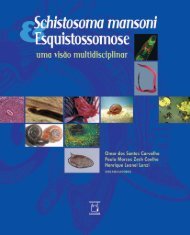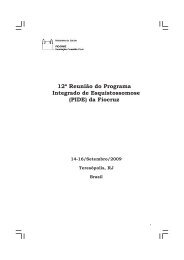English pdf, 1.64Mb - World Health Organization
English pdf, 1.64Mb - World Health Organization
English pdf, 1.64Mb - World Health Organization
You also want an ePaper? Increase the reach of your titles
YUMPU automatically turns print PDFs into web optimized ePapers that Google loves.
Objectives and overviewSchistosomiasisThe objectives of the SWG were to define the research needs in the field of schistosomiasis andto assess the effectiveness of currently available tools and strategies for control. In addition, theSWG was asked to review global research activities, identify gaps between needs and ongoingresearch efforts, and indicate the means to address these gaps. The SWG was also expectedto indicate ways of strengthening existing and new partnerships and to provide TDR with anoverall strategy and scientific direction for research on schistosomiasis for the next five years.GeneralThe SWG met in Geneva, 14–16 November 2005, to review the current needs for research andmake recommendations regarding support. Fourteen invited working papers on various topics(annex 2) were presented by members of the SWG.It was unanimously felt that research priorities, although important for the SWG to agreeon, would be of little value unless the impact of schistosomiasis was better defined. Athorough meta-analysis, presented by Dr C. King, pointed out that the strong negative biasof the current disease-adjusted life years (DALY) index for schistosomiasis is largely due tofailure to include less well recognized (subtle) pathological signs such as anaemia, delayedgrowth/development, cognitive impairment, and sexual dysfunction. Rather than exclusivelyaddressing organ-specific morbidity arising from egg-associated inflammatory reactions andfibrosis, a wider morbidity spectrum should be acknowledged. It was generally felt that arevision of the DALY index to better reflect the true burden of disease is thus overdue. As thisquestion influences all other activities under review, the SWG recommended that investigatorsregularly collect straightforward data, e.g. on anaemia, and also develop standardized measuresfor more intricate outcomes of infection such as on work capacity and cognition. Longitudinalclinical studies and operational research should be initiated in endemic areas and target notonly the general population but particularly the many high-risk sub-groups. Such studiesshould include treatment interventions combined with outcome assessments at multiple timepoints following therapy and results should be linked to studies of socioeconomic status aswell as patients’ estimates of the impact of infection on quality of life.DiagnosticsTo gain a more complete view of schistosomiasis and its impact on society demands thedevelopment of better tools in terms of rapid diagnostic techniques, image-assisted clinicaldiagnosis, and reliable predictive risk maps based on geographical information systems(GIS) and satellite-based remote sensing (RS). Field diagnosis continues to rely on directmicroscopy, as it has since the beginning of control programmes. However, the relativeinsensitivity of this technique is a problem which has gained prominence during the lastReport of the Scientific Working Group on Schistosomiasis, 2005 • TDR/SWG/07








